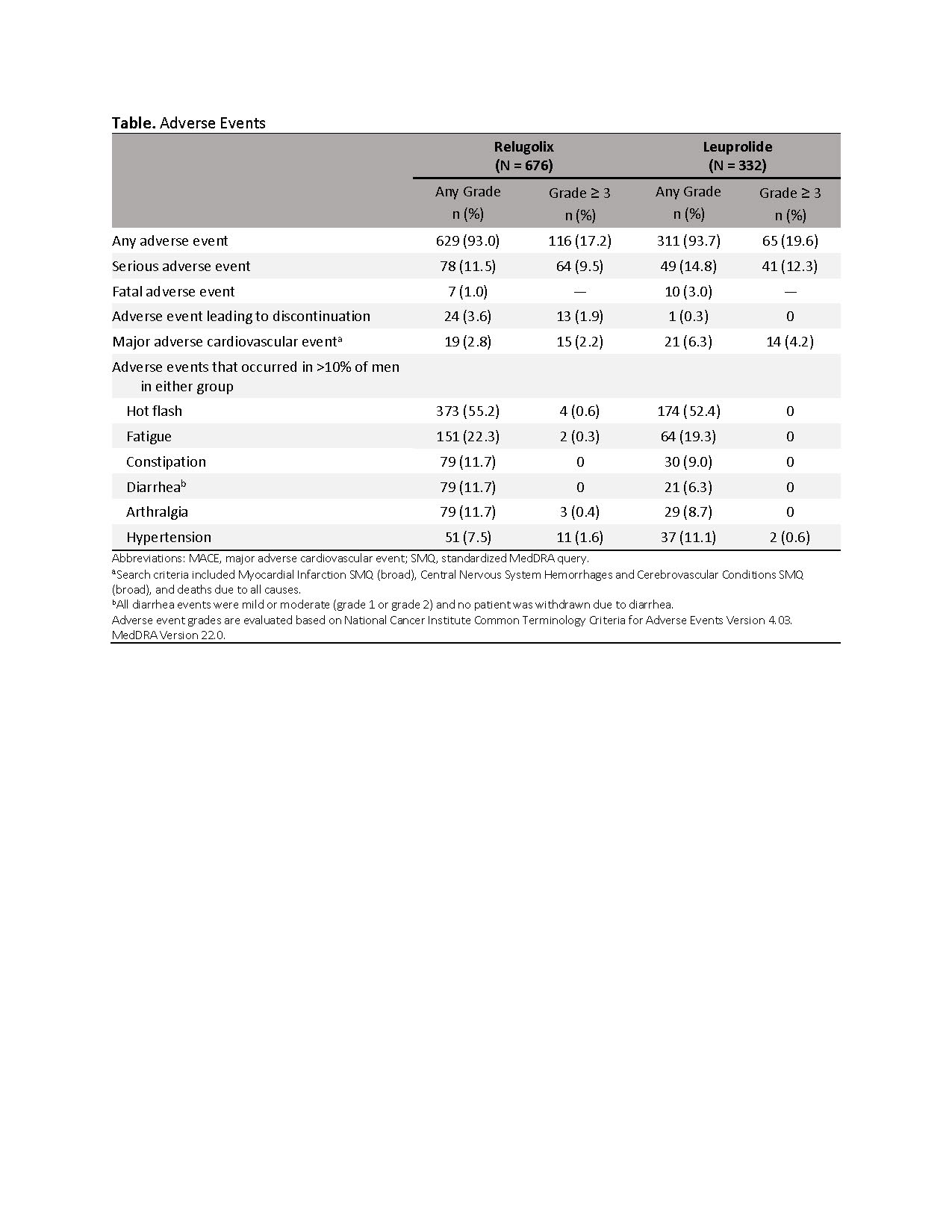Back
Poster, Podium & Video Sessions
Podium
PD35: Prostate Cancer: Advanced (including Drug Therapy) II
PD35-08: Oral Relugolix for Androgen Deprivation Therapy in Advanced Prostate Cancer: Pooled Safety Analyses from Randomized Controlled Studies
Sunday, May 15, 2022
8:10 AM – 8:20 AM
Location: Room 252
James L. Bailen, Jeffersonville, IN, Fred Saad, Montreal, Canada, Daniel J. George, Durham, NC, Bryan Mehlhaff, Springfield, OR, Michael S. Cookson, Oklahoma City, OK, Daniel R. Saltzstein, San Antonio, TX, Ronald Tutrone, Towson, MD, Bruce Brown, Andria G.M. Langenberg, Sophia Lu, Jina Lee, Brisbane, CA, Sarah Hanson, New York, NY, Bertrand Tombal, Brussels, Belgium, Neal D. Shore*, Myrtle Beach, SC
- NS
Neal D. Shore, MD
Carolina Urologic Research Center
Podium Presenter(s)
Introduction: Relugolix is a highly selective, orally active, nonpeptide GnRH receptor antagonist approved for the treatment of men with advanced prostate cancer. In the phase 3 HERO study, relugolix demonstrated sustained testosterone suppression superior to that of leuprolide, a safety profile consistent with its mechanism of action, and a 54% decrease in risk of major adverse cardiovascular events relative to leuprolide. In order to provide a detailed summary of the relugolix safety profile, we analyzed pooled data from 2 randomized relugolix clinical trials.
Methods: The pooled safety analyses include data from 1012 men with advanced prostate cancer: 934 men (relugolix:622; leuprolide:308) from the phase 3 HERO study and 78 men (relugolix:54; leuprolide: 24) from the C27002 randomized phase 2 study. Only men who received either relugolix 120 mg orally once daily (360 mg day 1 loading dose) or leuprolide injections every 12 weeks for 24-48 weeks were included in the analyses. Safety assessments included clinical laboratory tests, reporting of adverse events (AE) (assessed according to the National Cancer Institute Common Terminology Criteria for AEs, version 4.03), and major adverse cardiovascular events (MACE; defined as nonfatal myocardial infarction, non-fatal stroke, and death from any cause). Individual patient data were pooled and results of all analyses were summarized descriptively.
Results: The overall incidence of AEs was 93.0% and 93.7% in the relugolix and leuprolide groups, respectively (table). Hot flash was the most common AE in both groups (55.2% in the relugolix group and 52.4% in the leuprolide group). Grade = 3 AEs occurred in 17.2% and 19.6% in the relugolix and leuprolide groups, respectively. The most common grade = 3 AEs were hypertension (1.6% vs 0.6%) and syncope (1.0% vs 0.9%). Fatal events were reported for 1.0% of men in the relugolix group and 3.0% in the leuprolide group. MACE incidence in this pooled analysis was 2.8% in the relugolix group and 6.3% in the leuprolide group.
Conclusions: In the pooled safety analyses of 2 randomized clinical studies in advanced prostate cancer, relugolix was generally well tolerated, with a lesser incidence of MACE relative to leuprolide.
Source of Funding: Myovant Sciences GmBH, in collaboration with Pfizer.

Methods: The pooled safety analyses include data from 1012 men with advanced prostate cancer: 934 men (relugolix:622; leuprolide:308) from the phase 3 HERO study and 78 men (relugolix:54; leuprolide: 24) from the C27002 randomized phase 2 study. Only men who received either relugolix 120 mg orally once daily (360 mg day 1 loading dose) or leuprolide injections every 12 weeks for 24-48 weeks were included in the analyses. Safety assessments included clinical laboratory tests, reporting of adverse events (AE) (assessed according to the National Cancer Institute Common Terminology Criteria for AEs, version 4.03), and major adverse cardiovascular events (MACE; defined as nonfatal myocardial infarction, non-fatal stroke, and death from any cause). Individual patient data were pooled and results of all analyses were summarized descriptively.
Results: The overall incidence of AEs was 93.0% and 93.7% in the relugolix and leuprolide groups, respectively (table). Hot flash was the most common AE in both groups (55.2% in the relugolix group and 52.4% in the leuprolide group). Grade = 3 AEs occurred in 17.2% and 19.6% in the relugolix and leuprolide groups, respectively. The most common grade = 3 AEs were hypertension (1.6% vs 0.6%) and syncope (1.0% vs 0.9%). Fatal events were reported for 1.0% of men in the relugolix group and 3.0% in the leuprolide group. MACE incidence in this pooled analysis was 2.8% in the relugolix group and 6.3% in the leuprolide group.
Conclusions: In the pooled safety analyses of 2 randomized clinical studies in advanced prostate cancer, relugolix was generally well tolerated, with a lesser incidence of MACE relative to leuprolide.
Source of Funding: Myovant Sciences GmBH, in collaboration with Pfizer.


.jpg)
.jpg)